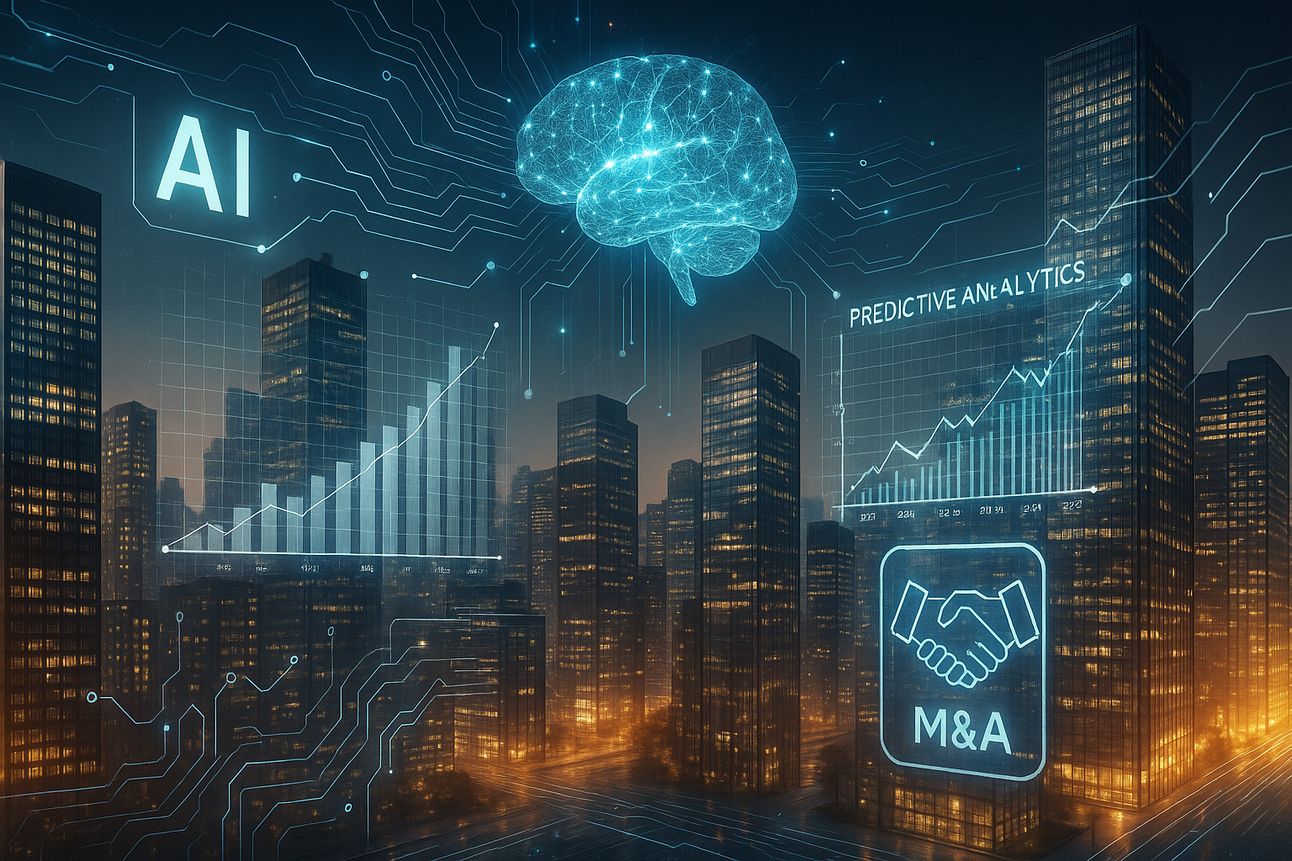- The AI Check In
- Posts
- 🛟 AI in M&A Deals: Unlock Premium Exits, Avoid Regulatory Traps
🛟 AI in M&A Deals: Unlock Premium Exits, Avoid Regulatory Traps
PE firms and banks are using AI to capture billions in value, yet hidden biases and weak oversight can sink the entire play. Move faster, exit smarter, and learn where boards must tighten their grip to unlock alpha with AI-led exits.
Rewrite the rules. Outmaneuver competitors. Stay two steps ahead of regulators.
AI Check In delivers sharp, globally relevant intelligence on AI governance, financial risk, and capital automation.
Already briefing strategy, risk, and compliance leaders at the world’s most influential banks, including JPMorgan, Citi, and Bank of America.
What to expect this edition:
🛟 Need to Know: Governing AI in private equity and M&A → New risks, new playbooks
🥷 Deep Dive: AI in M&A → From valuation to deal execution
📈 Trends to Watch: The next AI frontiers in PE and banking exits
⚔️ Vendor Spotlight: Precision tools for AI-enabled deals
The AI race is on. Let the games begin.
🛡️ Enjoying AI Check In? Forward this to a colleague who needs to stay two steps ahead.
📬 Not subscribed yet? Sign up here to receive future editions directly.
🛟 Need to Know: Governing AI in Private Equity and M&A → New Risks, New Playbooks

In M&A, AI is moving from the back office to the front line, driving valuation modeling, deal sourcing, and exit timing.
Regulatory attention is intensifying.
The SEC’s 2024 roundtable on AI in Financial Markets signals that AI-driven valuations and deal automation will soon face standards similar to SR 11-7. Boards should also align with the NIST AI Risk Management Framework (AI RMF) and ISO/IEC 42001, especially for global transactions.
With AI-specific state moratorium provisions excluded from the now-passed “Big Beautiful Bill,” the U.S. now faces a fragmented regulatory landscape. California’s DFPI is evaluating AI’s role in private investment transparency and potential conflicts, increasing multi-jurisdictional compliance complexity.
Boards face new blind spots.
AI valuations often lack assumption provenance, complicating oversight. Documentation of model design, drift logs, and override protocols is now essential. Bias audits and fairness reviews are critical when AI shapes pricing or target decisions.
Cybersecurity and privacy risks are rising. AI systems handle sensitive target data, introducing breach, poisoning, and regulatory exposure risks. Boards must validate vendor controls and ensure readiness under SEC cyber guidelines and state privacy laws.
Cross-border deals compound this. Divergent data sovereignty requirements and evolving AI regulations (e.g., EU AI Act) demand localized governance.
Cultural adaptation is vital. Deal teams must shift from instinctive speed to disciplined transparency. Incentives and training must reinforce a governance-first mindset.
🥊 Your Move:
Tighten AI model oversight now to pre-empt coming federal and state enforcement waves. Boards should also demand clear data lineage from vendors to avoid inherited bias or opaque third-party data risks in valuation models.
Require explainability and robust audit trails from internal and vendor AI systems. Not every training input or tuning weight, but a clear line of sight into decision logic and risk controls.
Refine team incentives to align compensation with risk-adjusted outcomes, not just closed deals.
🥷 Deep Dive: AI in M&A → From Valuation to Deal Execution

AI is now a frontline force in U.S. M&A, reshaping how deals are sourced, valued, and closed.
In the first nine months of 2024, U.S. M&A volume hit $2.5 trillion (up 16% YoY), with private equity accounting for nearly 40% (Bain & Co.). Over 70% of PE dealmakers now rely on AI to sharpen their edge.
Goldman Sachs is actively exploring the potential of generative AI to transform mergers and acquisitions (M&A). Their white paper, "How to Unlock an AI-Driven M&A Supercycle," discusses how AI could drive strategic transformations across industries, potentially leading to a surge in M&A activity.
Bank of America has been recognized for leveraging AI in due diligence processes. While specific metrics are proprietary, the integration of AI tools like Kira Systems has been noted to enhance the efficiency and accuracy of contract analysis during M&A transactions.
Citigroup has invested in AI-driven compliance solutions, such as Quantifind, to enhance anti-money laundering (AML) and know-your-customer (KYC) processes. These tools aid in real-time decision-making, which is crucial for evaluating fintech valuations and terms.
Outside the U.S., AI adoption remains cautious. Japanese and Chinese funds focus on portfolio analytics, Singaporeans on macro signals. UBS is ahead in European AI usage, scanning private acquisition targets at scale, and BNP Paribas’s Mistral AI deal signals readiness for broader AI integration across multiple business lines.
Post-close, AI monitors synergies and cultural integration to prevent value erosion. Yet AI failures loom: boards must demand scenario stress tests and clear escalation triggers.
Predictive exit scoring is emerging, allowing proactive divestitures and premium captures.
Meanwhile, legacy tech stacks slow AI’s full impact. Your team’s future dealmakers expect AI-native workflows and hybrid decision authority. Banks need to move to attract this next cohort of talent.
🥊 Your Move:
Stress-test AI assumptions rigorously and design clear override protocols to mitigate hidden risks.
Integrate AI into diligence and post-close workflows while being intentional with human checkpoints.
Build AI-native leadership pipelines and modernize tech stacks to unlock full value.
📈 Trends to Watch: The Next AI Frontiers in PE & Banking Exits

From predictive exits to AI-driven orchestration, these five emerging trends signal where private equity and banking leaders will compete and how they must adapt their playbooks.
Predictive exit intelligence: Pioneered by firms like Carlyle, continuous exit scoring reshapes when and how assets are divested, enabling premium valuations. Expect this logic to migrate into banking portfolio and divestiture strategy.
Synthetic scenario stress-testing: Synthetic data adoption is an emerging trend among US PE firms, and is not widespread in banks. Those mastering it will pre-empt market shocks, optimize timing, and capture premium multiples before regulators demand it.
AI agent orchestration: Early pilots suggest AI agents could one day handle term sheet negotiations and dynamic risk updates autonomously. Liability and governance remain critical bottlenecks.
Talent transformation: Hybrid AI-native dealmakers are emerging as the new standard, blending technical fluency with strategic judgment. Banks and PE firms are investing in specialized talent pipelines to stay competitive.
Cracking legacy tech: The biggest immediate barrier is banks’ own aging code bases and fragmented data stacks, which stall AI deployment. GenAI-powered code translation and AI process overlays are emerging as pathways to modernize without wholesale system replacements.
🥊 Your Move:
Launch pilots in predictive exit analytics and synthetic scenario testing now to secure first-mover advantages and regulatory readiness.
Invest in hybrid leadership and modernize tech stacks gradually using AI overlays to remove structural blockers.
Prepare governance frameworks and override protocols early to enable controlled scaling of AI agent orchestration.
⚔️ Vendor Spotlight: Precision Tools for AI-Enabled Deals
Kensho (S&P Global)
Summary: AI analytics platform for large-scale financial and market data, delivering predictive insights and scenario modeling.
Used by: JPMorgan, Bank of America, major hedge funds.
Pros: Deep macro and micro trend analysis; significant research efficiency gains.
Cons: Locked into S&P data ecosystem, limiting external flexibility.
Palantir Foundry
Summary: Advanced data integration and analytics platform for unifying complex data environments.
Used by: Morgan Stanley, global PE firms.
Pros: Exceptional at integrating fragmented data systems, enabling real-time insights.
Cons: High cost and technical complexity; requires dedicated resources.
Kira (Litera)
Summary: AI contract analysis platform accelerating diligence and compliance reviews.
Used by: Bank of America, major law firms, global PE teams.
Pros: Cuts review times, improves risk flagging accuracy.
Cons: Narrow focus; not designed for valuation or strategic analytics.
Additional context: Enterprises increasingly leverage broad AI platforms (Microsoft Azure AI, Google Cloud AI, Amazon SageMaker) to create custom, integrated M&A solutions, underscoring an expanding toolkit for CFOs and banking leaders.
🥊 Your Move:
Assess vendor fit against regulatory and reporting needs before integration — banks and PE firms require different architectures.
Pilot AI modules in targeted workflows to avoid large-scale platform lock-in. Negotiate modular integrations and exit clauses to preserve flexibility as AI vendor ecosystems evolve.
Demand strong audit trails and override options to maintain governance alignment.
🔮 Next Week: How Your AI Can Be Tricked into Leaking Sensitive Data
While your board debates model drift and fairness audits, threat actors are busy rewriting the rules. In finance, prompt injection and LLM jailbreaks aren’t theoretical, they’re operational weapons.
Next week, we dissect real-world failures, show how retrieval-augmented generation (RAG) can backfire, and outline why token sanitization may be your last true line of defense.
Yours,

💌 Was this newsletter shared with you? Join banking and finance leaders receiving weekly AI governance briefings.
📘 Subscribe to AI Check In here.
⚡ Share the edge — forward this edition to a colleague interested in AI, risk, or innovation initiatives.
Disclaimer
This newsletter is for informational and educational purposes only and should not be considered financial, legal, or investment advice. Some content may include satire or strategic perspectives, which are not intended as actionable guidance. Readers should always consult a qualified professional before making decisions based on the material presented.